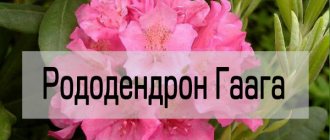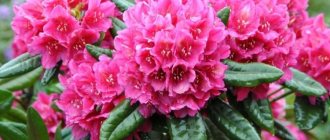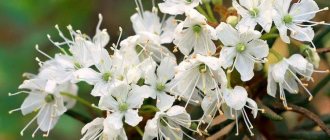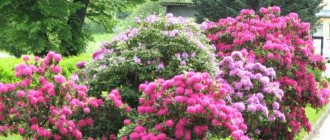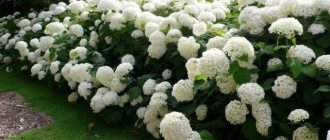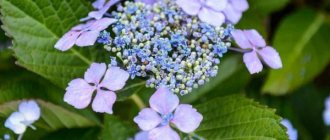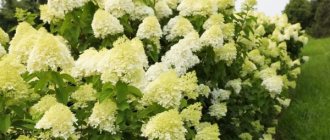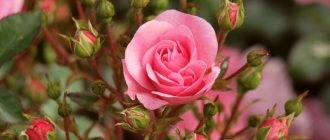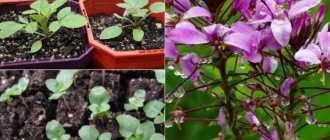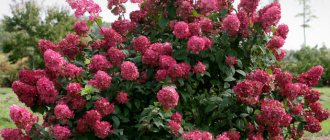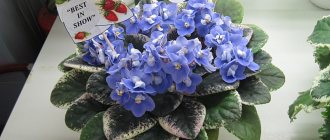Homeland of the plant
Rhododendron Katevbinsky appeared in Europe in 1809, it was brought from North America. It was one of the first introduced species, which spread very quickly due to its unpretentiousness and winter hardiness.
Full size shrub
For your information! At the moment, the species is actively used not only in landscape design, but also in breeding programs to obtain new evergreen frost-resistant varieties.
In nature, rhododendron can be found in North America, in particular in its eastern part, in the Allegheny Mountains. Shrubs form entire fields in open areas or grow in groups among forests. Emerald green specimens are also common in Japan.
The flower came to Latvia in the mid-19th century; in the climatic conditions of the Baltic states, rhododendron blooms and bears fruit profusely. Thanks to the shrub’s ability to withstand frosts down to −30°C, it can be found in the Far East and Kamchatka.
Kinds
Based on the original species of Katevbinsky rhododendron, hybrids have been bred that are distinguished by winter hardiness, the shape of the bush and inflorescences, and the color of flowers. Popular ones are:
- Album (Catawbiense album).
- Grandiflorum.
- Katewbinse Burso.
- Cunningham's White.
Despite all their differences, they have common features that emphasize their belonging to this plant species.
Album
The shape of the bush is elongated upward, its height is 3 meters. It blooms with large white inflorescences with a yellow center. Flowering lasts from the end of May to the last days of June. Withstands winter temperatures down to -30 degrees.
Grandiflorum
The most common type of Katevbinsky rhododendron, the first variety bred on the basis of a wild species. The bush has the shape of a ball with a diameter of 2.5 meters. Blooms profusely from the beginning of May for a month. Flowers are white, pink, purple, collected in inflorescences. Tolerates temperatures down to -32 degrees.
Bourso
A rhododendron hybrid, very winter-hardy (down to -32 degrees), retains all the properties of the species. The bush has a spreading shape and tends to grow in breadth.
White
The rhododendron hybrid Cunningham's White is called White. The snow-white flowers have a central petal strewn with small purple spots. The length of the petal is 5 centimeters, 9 flowers are collected in the inflorescence.
Botanical description of Rhododendron Grandiflorum
Catawbiense rhododendron (lat. Rhododéndron Catawbiense) is a type of evergreen shrub whose lifespan reaches 100 years.
Caucasian rhododendron in the mountains: when to bloom
In suitable growing conditions it can reach a height of 2 to 4 m, and the plant is wider than it is tall. By the age of 10, it reaches 1.5 m in height, adding 10 cm per year.
While the plant is young, its shoots have a felt surface; over time they become smooth. The leaves are oblong, the ends can be both blunt and sharp, the maximum length is 15 cm, width 5 cm. The upper part of the leaf is dark green, has 16 pairs of veins, the lower part is pale, bare.
The most popular varieties:
- Catawbiense Grandiflorum (Rhododendron Catawbiense Grandiflorum);
- Album Novum (Rhododendron Catawbiense Album Novum);
- Roseum elegans (Rhododendron Catawbiense Roseum Eleganсe);
- Purpureum (Rhododendron purpureum grandiflorum).
For your information! The flowering period lasts from late May to mid-June, sometimes lasting until July. The fruits ripen in October.
The description of the rhododendron Catawbiense Grandiflorum states that this is the oldest and most popular hybrid variety, which was obtained from a wild plant in the early 19th century. The crown reaches 3.5 m in diameter, the flowers are lilac with yellow and orange specks.
When is the best time to plant rhododendron?
Experts recommend planting rhododendron in April - mid-May or from September to mid-November - this is the most favorable time.
In regions with a cold climate (Middle Zone, Moscow region, North-West, Leningrad region, Urals and Siberia) it is better to plant in the spring.
Before autumn, the rhododendron will get stronger and take root better, which will increase its chances of a successful winter.
Rhododendron Katevbinsky
Flowering of Katevbinsky rhododendron
Flower growers have fallen in love with the large-flowered rhododendron Catawbiense Grandiflorum for a reason. It is highly decorative all year round. While the bush has not bloomed its flowers, it attracts the eye due to its bright, large, smooth leaves.
Rhododendron yellow: deciduous, azalea pontica
Flowering lasts only a month. Each inflorescence consists of 15-20 flowers. The inflorescences are bell-shaped and wide-funnel-shaped, reaching a diameter of 15 cm. Each flower is a bell and can be white, yellow, violet, red, purple or lilac.
In order for flowering to be spectacular and bright, the shrub needs to be watered and fed abundantly before and after this period. This way the plant will be saturated with nutrients and will not be depleted.
Note! If the rhododendron does not bloom, most likely the growing location is not suitable for it and there is not enough moisture.
Rhododendron leaves close up
Queen of the Flower Ball: Azalea Katevbinskaya
Azalea Katevbinskaya is an evergreen shrub, one of the most vigorous and winter-hardy varieties.
It grows 6-8 cm per year, and an adult plant can reach 2-3 meters in height. The dark green, leathery and shiny leaves are also impressive in size - they grow up to 15 cm long. The trunk may be dark gray or have a brown tint. The flowers look like wide (6 cm) bells of lilac or purple color with a yellow-red pattern. There can be up to 20 of them in an inflorescence. Hybrid forms of Katevbinskaya azalea boast crimson, purple, red, white, pink and blue flowers.
The root system of azalea is shallow - 30-40 cm. It develops mainly in litter and humus.
Types of rhododendron katevbinsky
— Album ( Catawbiense Album)
The pink buds of this species are funnel-shaped and marked with white, green or brown spots. Like all azalea flowers, they are odorless, but they are striking in the density of their inflorescences (13-20 flowers each).
— Grandiflorum (Catawbiense Grandiflorum)
One of the most common and reliable varieties. Its flowers, which bloom in June, are light purple in color with greenish spots, and the upper petals are decorated with a golden brown pattern. The bush grows thick and powerful; a spreading crown of compact inflorescences crowns a trunk with dark gray bark.
— Boursault ( Catawbiense Boursault)
The dark gray trunk of this rhododendron is crowned with a spreading crown of dense dark purple inflorescences with greenish-yellow spots. The height of the bush usually reaches one and a half to two meters.
— White (Catawbiense Cunningam White)
Numerous white flowers of this species are decorated with yellow-green spots. It happens that it blooms twice during the summer. In case of freezing in winter, it is easily restored.
Rhododendron katevbinsky grandiflorum - planting and care
- landing
The optimal time for planting is spring. When purchasing seedlings, it is important to make the right choice: from self-rooted and grafted seedlings, you need to choose the first option.
Azalea is
a light-loving plant, but you should not choose an open place for it - the plant can burn from direct rays of the sun. It is better to plant it in a place protected from the wind in partial shade, for example, under the canopy of trees. Rhododendron loves water very much, so before planting it would be a good idea to place the seedling in water .
At the site chosen for planting, you need to dig a hole 50 x 70 cm. The root system does not need to be buried - it should rise 2-4 cm above the soil level, taking into account subsequent subsidence.
- soil
Rhododendron loves fertile, fresh, slightly acidic or acidic soil . It should be loose, enriched with organic matter. Peat and leaf soil mixed with sand and rotted pine sawdust are suitable. Good drainage and annual mulching with peat and pine needles are required. They will retain moisture and protect the roots from weeds and damage.
— watering
Azalea does not tolerate heat and dry weather well , so in summer it requires abundant and deep watering. However, do not allow waterlogging and stagnation of water - the plant cannot tolerate it either. Watering with soft, acidified water is recommended twice or thrice a week.
— fertilizer/feeding
It is recommended to feed young shrubs in early spring and after flowering . It is enough to fertilize adult plants once a season. The dose of fertilizing is one bucket per root and includes rotted cow manure and decomposed compost.
Mineral fertilizers with NPK in a ratio of 2:1:1.5 have a beneficial effect on the health of the plant - 30-40 g per square meter. It should also be applied in the spring; it is better to give it to young plants in liquid form.
After flowering, you can fertilize with a mixture of phosphorus and potassium fertilizers (2:1) - this will have a good effect on the process of bud formation next year. However, it is better not to postpone fertilizing until the end of summer and later, otherwise new shoots will grow that will freeze in winter.
— flowering
Rhododendron blooms in late May - early June and delights gardeners with bright colors for 3-4 weeks. The diameter of the lush crown, with proper care of the plant, can reach two meters. After flowering, all wilted inflorescences must be removed so that they do not interfere with the formation of new buds.
- pruning
Pruning is not necessary and may delay growth and flowering. However, if you want to make the rhododendron crown neat, you can trim it in May. You can replace pruning with pinching.
- methods of reproduction
Katevbinsky rhododendron is grown from seeds that ripen at the end of October. They adapt well to local conditions, and the color of the resulting plants will vary. This way you can get multi-colored flowers and make the flower bed as varied as possible.
You can also propagate rhododendron with semi-lignified shoots 7-9 cm long. They are cut in mid-spring and mid-summer, so that the cut is oblique. The 3 bottom leaves need to be removed, leaving a tip of 0.5 cm, the remaining leaves need to be cut in half.
The shoots will be planted in a substrate of 3 cm of coarse sand and 10 cm of coniferous soil. A drainage layer of 2-3 cm will consist of pebbles and broken shards.
Wintering rhododendron
- autumn care - preparation for winter
At the end of summer, it will be useful to add colloidal sulfur to the soil: it will slow down the growth of fungi and acidify the soil. It is also recommended to treat rhododendron with a fungicide against fungi. Continue watering until the ground freezes completely.
- how to cover a rhododendron
In winter, it is necessary to protect evergreen shrubs from the sun and wind. For this, shelters made of sticks, boards or boxes are sufficient. The whole thing needs to be wrapped in non-woven material on top. If the rhododendron grows in the shade, you can take a chance and leave it without shelter for the winter.
Diseases and pests
Rhododendrons growing in open areas, as well as depleted plants that are not cared for properly, are more susceptible to diseases and pests.
Due to excessive watering,
fungal diseases . Infected plants should be periodically sprayed with a solution of Bordeaux mixture. Diseased specimens and stumps will have to be burned to destroy foci of fungal spread.
Insect pests include: furrow weevil, spider mite, acacia false scale, tobacco thrips, rhododendron mite, greenhouse and rhododendron whiteflies. Special insect repellents will help fight them Affected leaves must be plucked and burned, shoots must be cut off.
Shrubs are also subject to attacks by gastropods (they need to be collected by hand, and to prevent them, molluscicides should be used) and crows pecking at the buds (bird scarers can help).
A gardener rarely has difficulty growing multi-flowered azaleas. She is quite unpretentious, but very impressive and can become a real queen of any flower garden.
See more photos of Katevbinskaya azalea below:
Useful video
Watch a video with the beautiful Katevbinsky rhododendron:
Useful information You can read other materials on the topic and learn more about azalea/rhododendron:
If you find an error, please select a piece of text and press Ctrl+Enter.
Features of reproduction
Rhododendron Schlippenbach: description
At home, rhododendron propagates by layering and cuttings.
Cuttings are cut in early summer. Each branch up to 15 cm long is cut at an angle of 45°, the lower leaves are removed, and the cuttings themselves are placed in a root formation stimulator for a day. After this, each shoot is planted in a fertile acidic substrate for rhododendrons and a greenhouse is made. Rooting will occur in about a month.
Scheme of propagation by cuttings
An easier way is propagation by layering. To do this, the lower branches are tilted to the ground and sprinkled. The edge of the shoot is tied to a peg. After a few months, the cuttings will produce roots and can be separated from the mother plant in the spring.
Important! For the rooting process to be successful, the soil with layerings must be well moistened.
Growing rhododendron in open ground
The word rhododendron is translated from Greek as rose tree. It received this name due to its flower, which resembles a rose.
Description of rhododendron
Rhododendron belongs to the heather family, which includes evergreen plants, shrubs and trees that completely or partially lose their leaves at certain times of the year. The most famous and widespread are azaleas grown indoors, in greenhouses and greenhouses.
It grows in the subtropics and temperate zone of the Northern Hemisphere, although it is also found in the Southern Hemisphere. There are 18 known species in Russia, which are distributed in the Caucasus, Siberia and the Far East. They grow singly or in groups forming entire thickets, in the mountains or under trees in the forest, in swampy areas or in the tundra. The place should be shaded and moist, but water should not stagnate in the soil. There is dampness in the air.
Types of rhododendron vary in height (from 10-20 cm to 30 m) and in flower size (several mm and more than 20 cm). Simple and compound leaves with different edges. Bisexual flowers with a corolla of different colors: lemon, pink or purple-violet. They are combined into simple and complex inflorescences, and are extremely rare alone. The fruit is represented by a five-leaf capsule that opens downwards. The seed resembles a stick 0.5-2 mm. Numerous small roots are located on the surface. Characterized by slow growth. Can be propagated in various ways.
Rhododendron is a poisonous plant containing andromedotoxin. This substance first has an stimulating effect, and then a depressant effect, leading to death. Tannins are present in the bark and leaves.
Types and varieties of rhododendron
Typically, shrub varieties are grown in gardening.
Landing rules
Despite the unpretentiousness of rhododendron Grandiflorum and the ease of caring for it, some conditions must be met. An incorrectly selected soil composition can lead to a lack of flowering or the death of the entire shrub. If you choose the right planting site, then nothing else is required except watering.
Boarding time
The plant should be planted in a permanent place before flowering - in early spring after frost or in early autumn. Rhododendrons have a shallow root system, so the top layer of soil should already be warmed up, and precipitation could not harm the shrub.
Flower shoots are sensitive to drought, so the mid-season is best for replanting.
Place and soil for planting rhododendron katevbinskogo Grandiflorum
Rhododendron Grandiflora tolerates shade well, but will still feel better on the south side, but without direct sunlight. Places with diffused light, such as under trees or a canopy, are also suitable.
Important! When choosing a place to plant, you need to check in advance whether there are any drafts there. Constant winds can dry out the shoots of the plant.
Soil requirements:
- slightly acidic or sour;
- wet;
- loose;
- rich in organic matter.
Before planting, the rhododendron can be placed in water so that it is saturated with moisture. Increased soil and air humidity is the key to good flowering. Therefore, it is recommended to install automatic waterers in the garden plot or manually spray the shoots daily.
Note! It is better to plant shrubs next to those trees that have similar soil requirements. This way, neighbors will not take nutrients from each other. Fruit trees can lead to depletion of shrubs, as they draw all the water from the soil.
If there is frequent precipitation in the region, this can lead to stagnation of moisture, which leads to rotting of the roots. To protect the ornamental shrub, it is better to immediately plant it on a hill. In temperate climates, a drainage layer is made in the planting hole.
To acidify the soil, you can mix several types of soil: garden soil, peat soil, rotted pine soil, clay soil, and add sand. Sand and clay should be no more than 20% to maintain breathability.
How Rhododendron Grandiflorum blooms
Seedling preparation
It is best to use a seedling that is three years old, but the possibility of transplanting younger or older specimens is not excluded.
Before planting, the shrub is dipped in a container of water until no more air bubbles are released. Long roots can be trimmed, the rest can be simply straightened.
Important! When planting, the root collar of the Katevbinsky Grandiflorum rhododendron should remain above the ground.
Fertilizer application
Rhododendron katevbinsky Grandiflora absorbs many nutrients. In poor soils, its leaves will become pale and thin, and very few flowers will appear during the flowering period.
To avoid the above, plants are fed from the beginning of spring until the end of flowering. This is necessary for both young and adult shrubs. The last feeding is carried out when the bush has completely faded and new shoots begin to form.
Suitable for Rhododendron catawbiens Grandiflorum:
- organic fertilizers, in particular, semi-rotted cow manure, diluted in water in a ratio of 1:15;
- horn flour;
- calcium and magnesium sulfate;
- potassium nitrate.
At the beginning of spring, nitrogen preparations are introduced into the soil, in June compositions with potassium and phosphorus, and in July nitrogen is excluded.
Note! To preserve moisture and nutrients in the soil, the tree trunk circle of the shrub is mulched with pine needles.
Selection of seedlings and planting site
It is better to choose seedlings with closed roots. You need to make sure that this variety is adapted to cold climates and can successfully withstand frosty winters. You should carefully examine the seedling and make sure that all its parts are in order and there are no signs of diseases or harmful insects.
It is advisable to choose a site for planting rhododendron with the possibility of shading during the midday hours. The scorching sun and constant shadow will be equally destructive for the plant. The best option is to plant it near the northern wall of any building.
If the groundwater level is high, it would be prudent to plant the bush on a hill, otherwise the roots will be in danger of rotting.
The soil for rhododendron is saturated with humus, with an acidic or slightly acidic reaction - pH 5.5-6.0. Preference should be given to a mixture of clay and peat in a ratio of 1: 2. Neutral and calcareous soils are harmful to the plant.
It is important not to make a mistake when choosing neighbors for rhododendron. Its roots extend into the upper layer of soil; close proximity of plants with a similar feature will negatively affect the health of the bush
The best neighbors of rhododendron are apple and pear trees, pine, spruce and larch. It is not advisable to plant it next to other trees.
Rhododendron care requirements
In extreme heat, Grandiflorum rhododendron needs abundant watering; the soil is moistened with acidified water 2-3 times a week.
In May, you can do pinching to form a more luxuriant crown. Pruning negatively affects the growth and flowering of rhododendron.
There is no weeding of the soil near the bush, since the root system of rhododendron is close to the surface of the earth. Once every six months, you can add rotted pine needles under the bush to maintain the acidity and looseness of the soil. As an alternative, you can add a solution of vinegar, lemon juice or formic acid to the water for irrigation three times a month.
For your information! To preserve more nutrients, faded buds are removed in July.
Although the species is frost-resistant, it is better not to risk it and help it survive its first winter. Before frost, the bush is watered abundantly and the trunk is mulched. The top of the plant is covered with burlap or a hut made of wooden stakes is organized.
What is the difference from other types?
Rhododendron Katevbinsky, unlike many other types of evergreen Rhododendrons, has inflorescences with a wonderful subtle aroma. It is also worth noting that during the flowering period it blooms so magnificently that it has been given the name “Rose Tree”.
- The hybrid variety Katevbinse Burso is one of the most winter-hardy species, can withstand up to 30 degrees below zero, and likes to grow wide. Lilac-purple flowers are collected in large lush inflorescences.
- Purpureum hybrid is a spherical shrub with beautiful purple inflorescences (the color is very juicy), the inflorescences are large - 15 flowers each, odorless.
- Album (Catawbiense album) - this species has a slightly different shape - it is elongated upward, reaches a height of 3 m, its large flowers are white with a yellow core.
- When and how - flowering of Rhododendron Katevbinsky occurs in May - June, lasting about one month. The flowering is very intense, the inflorescences consist of 15 - 20 large flowers of various shades.
- Care before and after flowering - water well and do not forget about fertilizing, thanks to them the bush will not be depleted.
- What to do if it doesn’t bloom - it’s better to replant it in a more favorable place and water it well.
What should the soil be like?
You need loose, fertile soil, preferably slightly acidic (maybe acidic), moist, but without stagnant water.
Planting can be different: seeds and seedlings. When purchasing seedlings, it is better to choose self-rooted ones; they can be planted in spring and summer, preferably immediately in a permanent place in the garden, in partial shade.
Seeds can be sown from January to March in nutritious soil (necessarily loose), do not bury them deeply, you just need to press lightly
Water very carefully, it is best to spray the water. Before germination, the container with seeds must be covered with glass and provided with lighting 12 hours a day using a phytolamp. After the seedlings appear, remove the glass, continue to maintain humidity and lighting, and when 3 leaves grow, plant the seedlings in separate containers. In the spring or early summer, these “babies” can be planted in the garden in a suitable place protected from the winds (or a year later in the spring). They will begin to bloom after 2 or 3 years, with this planting method you can get a plant with improved properties
They will begin to bloom in 2 or 3 years, and with this planting method you can get a plant with improved properties.
Temperature
The lowest temperature that this shrub can withstand is 30 degrees below zero, and the highest is 30 degrees above zero, while the optimal temperature is from minus 10 to plus 25 degrees.
Rhododendron is very moisture-loving; in extreme heat it definitely needs deep watering about 2-3 times a week. It will also be useful in hot weather to sprinkle the bush with a hose only on the leaves. The water should be soft, preferably acidified.
- Twice a season you need to apply organic fertilizers in this form - a bucket of cow manure and rotted compost per bush.
- The rest of the time, fertilize with an aqueous infusion of organic matter; it is also good to add double superphosphate during the budding period; flowering will be even more magnificent.
Remove only faded buds.
It is best to replant the plant in the spring.
You need to decide in advance on the location and prepare the planting hole; it should be wide and deep enough - about 2 times larger than the root system of the bush. Add a nutrient substrate of peat, humus and well-rotted manure into it, mix everything and add drainage. We place the bush in the center of the hole, carefully add the nutrient mixture on all sides, compact it and water it. You need to pour a layer of mulch on top - you can use pine needles, sawdust or expanded clay. Before planting, the roots should be well saturated with water.
How to prepare for winter?
For the winter you definitely need:
- Mulch the tree trunk circle of the shrub, first water it well (before frost).
- You also need to build a reliable support from wooden stakes in the shape of a hut; you can also use covering material.
Pests and diseases
Rhododendron rarely gets sick, and this happens in the case of improperly selected soil or stagnant water. In poor growing conditions, spotting, rust, and chlorosis may appear. In this case, the plant is replanted, watering is adjusted, and treated with iron chelate.
Pests such as:
- bedbugs;
- scale insect;
- spider mite;
- aphid.
You can get rid of insects using fungicides; thiram and diazine are good for rhododendron.
As a preventive measure in spring and summer, every month it is necessary to spray the shoots with Bordeaux mixture.
Katevba rhododendron is the pride of any gardener. The shrub will thank you for the bright sun, acidic soil and abundant watering with gorgeous flowering.
